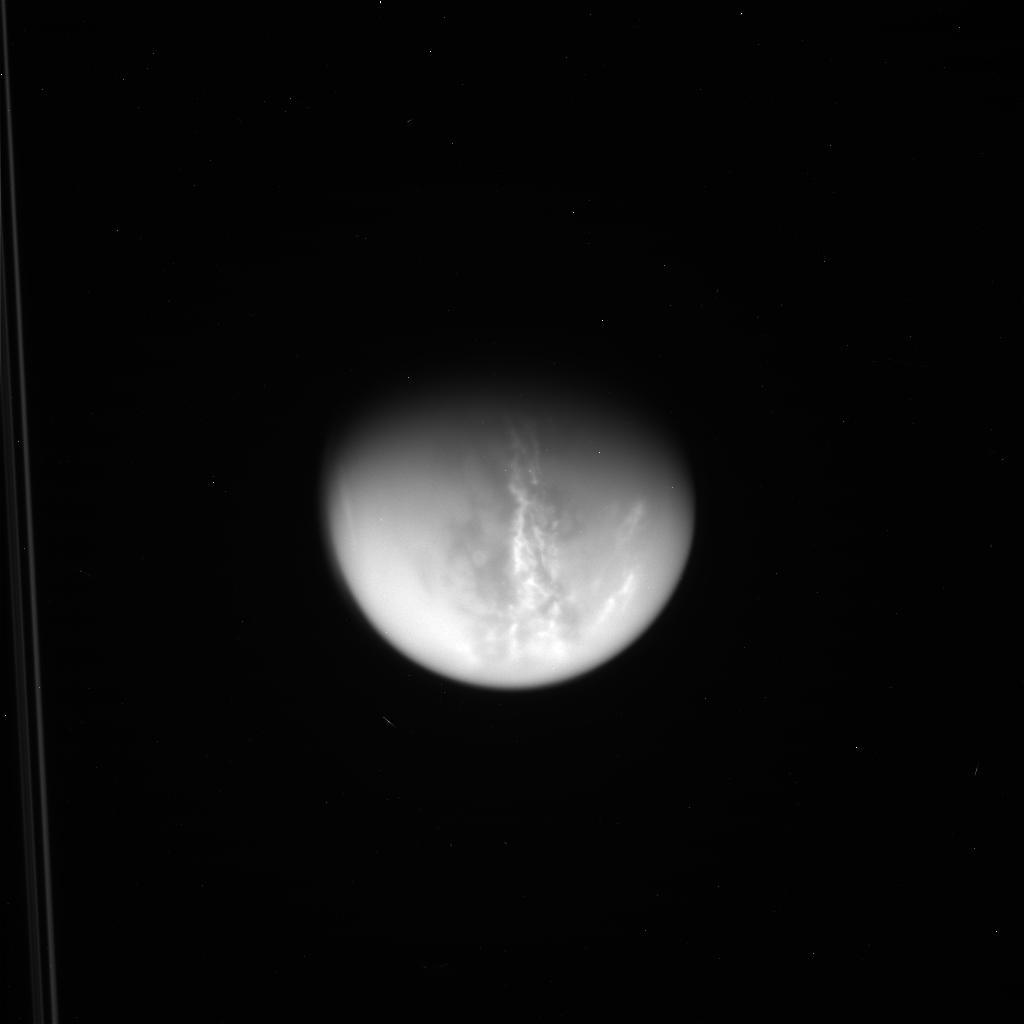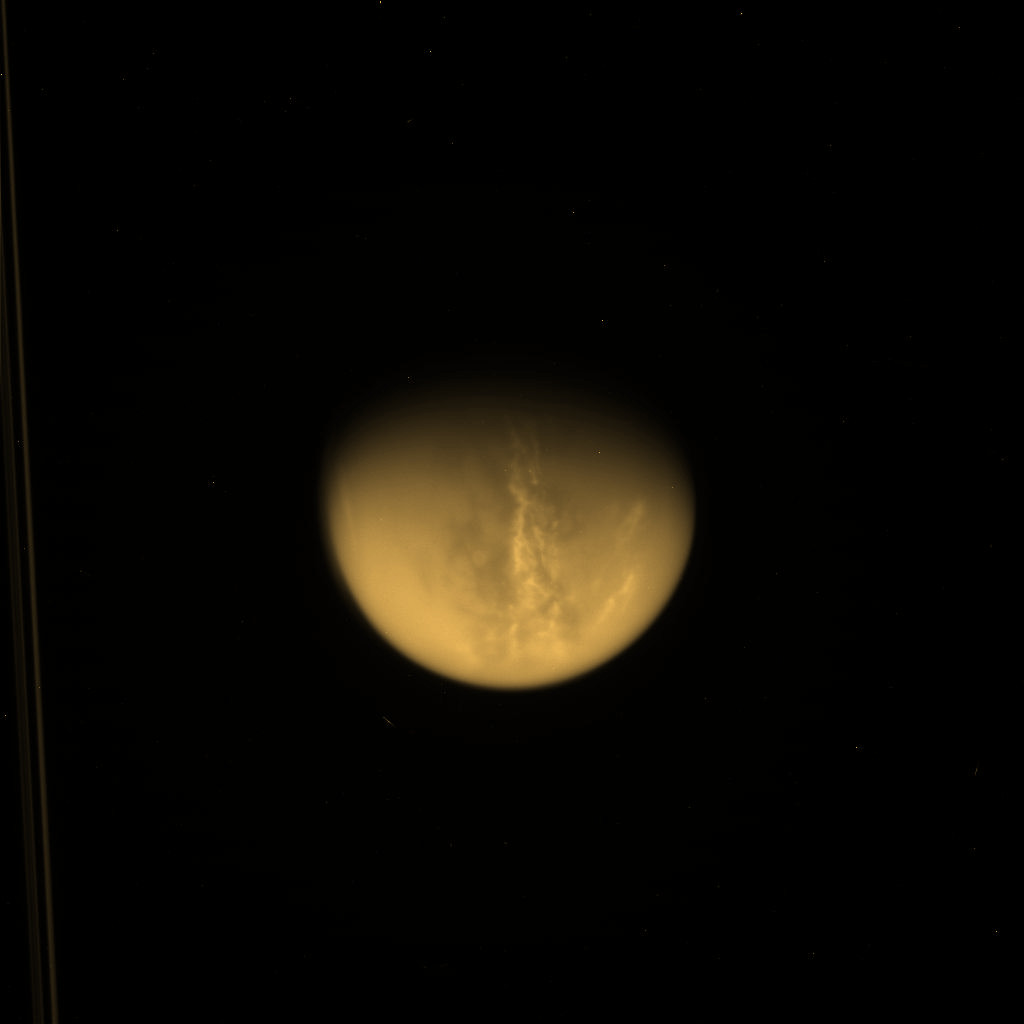April 8, 2021: A New Study Involving Kaitlyn Loftus Reveals That The Size Of Alien Raindrops Like The Raindrops On Titan May Be Relatively Similar To The Size Of Typical Raindrops On Earth
A new study entitled "The Physics of Falling Raindrops in Diverse Planetary Atmospheres", published in AGU's Journal of Geophysical Research: Planets on March 15, 2021 and involving Kaitlyn Loftus and Robin Wordsworth reveals that the various raindrops potentially encountered on other worlds in the Solar System or beyond are relatively similar in terms of size. A raindrop must be big enough to reach the surface of any planet or moon. If that raindrop is too big, it will tend to break up into smaller raindrops. Obviously, any atmosphere has its particularities. For instance, the atmosphere of Titan is dominated by molecular nitrogen like the atmosphere of the Earth but it contains a relatively significant concentration of methane, a molecule that is relatively scarce in the atmosphere of the Earth. In the harsh environment of Titan, methane can form clouds which can engender rainfall events like on Earth. Planetologists try to imagine or anticipate the characteristics of raindrops on Titan. The new research work makes things clearer regarding the physics, the dynamics or the chemistry of raindrops on other worlds like Jupiter, Saturn, Titan, Uranus or Neptune. Theories, simulations or models are likely to tell us a lot regarding the potential reality of other worlds.
In order to anticipate or determine the behavior of raindrops, we must understand fluid dynamics and thermodynamics. The physics of raindrops can be applied to raindrops of water in our own atmosphere, raindrops of methane in the atmosphere of Saturn's largest moon Titan, raindrops of sulfuric acid in the atmosphere of Venus, raindrops of helium in the atmosphere of Jupiter, raindrops of pure carbon in the form of diamonds in the atmosphere of Neptune or even raindrops of iron or quartz on potential exoplanets where the environmental temperature is extremely high. On the Red Planet Mars, raindrops of water can't be encountered but snowfall events involving carbon dioxide or dry ice can take shape. On the Gas Giant Jupiter, mushy ammonia hailstones can potentially fall. The researchers show that the raindrop size in any atmosphere will imply a particular shape of the raindrop, a particular terminal velocity of the raindrop and a particular evaporation rate of the raindrop. In other words, the planetologists are in a position to determine these three characteristics of the raindrop on the basis of its initial size. Will the raindrop released by the cloud reach the surface on the basis of its size, on the basis of its evaporation rate or on the basis of its speed ?
The growth mechanisms of the raindrop remain poorly understood but the scientists are in a position to demonstrate the close relationship between the size of the raindrop and the three characteristics of the raindrop mentioned here. The team of researchers also shows, by resorting to the equations related to raindrop falling and evaporation, that the raindrop capability to vertically transport latent heat and condensible mass can be well evaluated by a new dimensionless number. The outcome of the planetologists brings key elements in the process of determination or evaluation of precipitation efficiency, convective storm dynamics and rainfall rates. The chemistry, the physics or the dynamics of clouds, storms or rainfall events are fundamental in order to correctly understand planetary radiative balance or surface erosion related to rainfall events on worlds which contain an atmosphere with a meteorological cycle comparable to the meteorological cycle of the Earth. Beyond our planet, in the Solar System, the Opaque Moon Titan appears to be the perfect world to study the chemistry, the physics or the dynamics of rainfall events as well as erosion related to the action of rainfall events.
The researchers determine that the size of water raindrops will tend to be smaller on more massive worlds or bigger on less massive worlds. The maximum diameter or width of the raindrop is evaluated at 11.18 mm for a world whose mass is equivalent to that of the Earth, 7.07 mm for a world whose mass is equivalent to that of Jupiter and 29.96 mm for a world whose mass is equivalent to that of Titan. Are typical raindrops on Titan really bigger than typical raindrops on Earth ? What must be the size of the raindrop so that the raindrop can reach the surface of the planetary body ? The planetologists were in a position to determine that the size range of the raindrop that can reach the surface is quite limited. The correct radius of the raindrop that can reach the surface is found between approximately a tenth of a millimeter and several millimeters. One has to keep in mind that raindrops increase approximately a million times in volume during their development inside the cloud. If the raindrop is too big, it will tend to break up into smaller raindrops. If the raindrop is too light, it won't fall or it will evaporate during the fall toward the ground.
The scientists reveal that the maximum size of droplets that become rain is relatively similar in the atmosphere of various types of worlds. The maximum size of the droplet is in fact closely related to the level of the gravity. If the gravity is lower, the raindrops will tend to be bigger. The maximum size of the various types of droplets will tend to range from about half to six times the size of water rain on the Blue Planet. Kaitlyn Loftus who is a planetary scientist at Harvard University and who is the lead author of the new research work pointed out: "There's a fairly small range of stable sizes that these different composition raindrops can have; they're all fundamentally limited to be around the same maximum size." Kaitlyn Loftus and Robin Wordsworth mobilized math and physics principles in order to anticipate the way liquid water droplets fall in any atmosphere and the typical size range of the raindrop that falls from the cloud and that reaches the surface. Below a certain size, the raindrop will evaporate before reaching the surface. Above a certain size, the raindrop will engender smaller raindrops. The logic is the same for water droplets or methane droplets for instance.
The researchers focused their attention, in the first step, on the analysis of water raindrops on rocky planetary bodies like Earth and Mars, on the basis of several factors. They took into account atmospheric conditions like the environmental temperature, the air pressure, the relative humidity, the distance between the cloud and the surface and the strength of the gravity of the planetary body. They were in a position to determine that raindrops whose radius is smaller than approximately a tenth of a millimeter evaporate during the fall from the cloud. They were also in a position to determine that raindrops whose radius is larger than several millimeters break up into smaller droplets during their fall from the cloud. Later, the planetologists analyzed the potential behavior of water raindrops on much bigger worlds like the Gas Giants Jupiter and Saturn. They noted remarkable similarities in the behavior or movement of the raindrops on the various worlds they studied, from modern Earth to ancient Mars and the bigger planets of the Solar System. The composition of the atmosphere or the air doesn't appear to play a major role in the way the raindrops fall from the cloud. Let's note that on Jupiter or Saturn, the notion of surface is different since their atmosphere is extremely deep.
The calculations of the planetologists are in line with the idea that the alien raindrops whose composition can vary are quite close to the typical water raindrops on our planet. Titan appears to be an excellent natural laboratory to study the dynamics of exotic clouds, the dynamics of exotic raindrops or an extraterrestrial meteorological cycle. On Saturn's largest moon, there can be clouds of methane or even clouds of ethane. Raindrops on Titan can contain methane molecules as well as ethane molecules. What is the dynamics of those raindrops on Titan ? This study suggests that the largest methane raindrops on the Opaque Moon would be approximately twice the size of water rain on the Blue Planet. Kaitlyn Loftus is not in a position to say exactly why the maximum raindrop size appears so uniform but she advances that the remarkable size uniformity may be related to the right combination of surface tension of the droplet and density of the droplet. The new calculations allow us to have a better idea upon the environmental conditions of other worlds in the Solar System or beyond in other star systems. They bring new clues to the puzzle of planetology.
Rainfall events can be encountered on many worlds in the Solar System like Venus, Saturn, Jupiter, Uranus or Neptune. They play a major role in the climate of the world since they fuel the meteorological cycle or even the potential nutrient cycle as Kaitlyn Loftus pointed out. If we can model the meteorological cycle of a world like Jupiter or Titan, we can predict the meteorological cycle of other types of world beyond the Solar System. We can also better understand what we see, on the basis of space telescopes, in the atmosphere of some exoplanets as Tristan Guillot who is a planetary scientist at the Observatoire de la Côte d'Azur in Nice, France, argued. He pointed out: "Now with instruments like [the James Webb Space Telescope], which hopefully will soon be launched, we will have the capability to detect really fine spectra of exoplanetary atmospheres, including ones that are quite cooler than ones we're usually able to characterize, in which clouds and rain will occur." He concluded: "So these kinds of tools as they are developed will be very useful and important to interpret those spectra." The study of the meteorology of a world like Titan can allow us to better understand our own meteorology and the potential evolution of our climate.
- To get further information on that news, go to: https://news.agu.org/press-release/alien-raindrops-surprisingly-like-rain-on-earth and https://agupubs.onlinelibrary.wiley.com/doi/full/10.1029/2020JE006653 .

